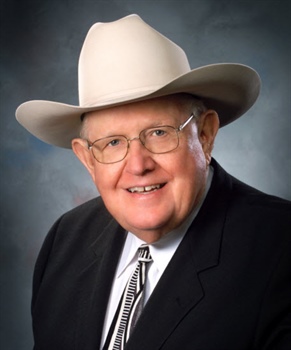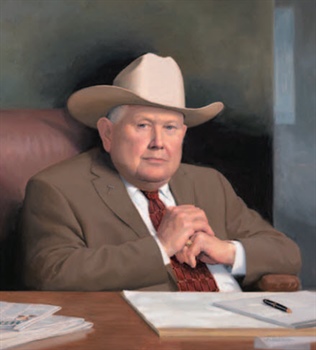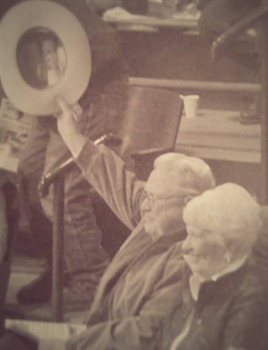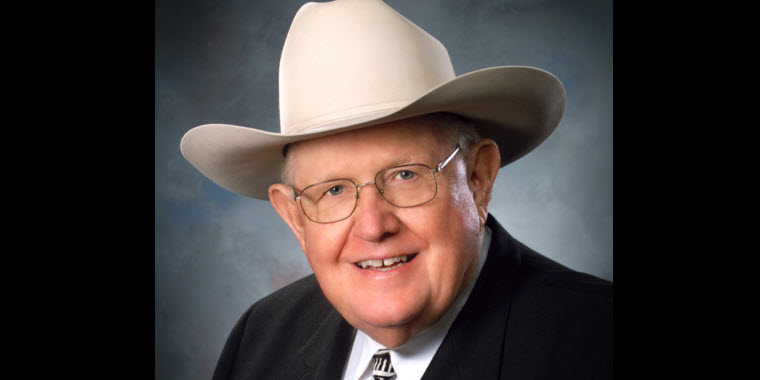PATRICK KING GOGGINS
1930 – 2015
Written by Linda Grosskopf & Bonnie Zieske
Pat Goggins was born in Orland, California, on May 28, 1930, the last of John and Pearl Goggins’ six sons. However, his family had roots in Montana, and they returned to Montana when their red-headed sixth son was still a toddler. Primarily a dairy farmer, Pat’s father eked out a living during the Depression as a sharecropper. The family’s total income in 1936 was $97, and it took much manual labor and elbow grease on the part of all members of the family to gather together that sum.
Too young to take an active part in World War II, Pat did his bit by helping his family grow crops to feed the soldiers. It was during this impressionable time in his life that Pat developed lifetime habits of hard work and thriftiness. Pat’s first livestock achievements came in August 1947 when his 4-H Hereford steer beat every other entry to walk away with Championship honors at the Open Division at the 1947 National Hereford Show.
The next two decades witnessed phenomenal changes in Pat’s life. On the day after Christmas of 1951, Pat married Babe Becker, a lovely second grade teacher. In the spring of 1952, he graduated from Montana State University with a degree in animal husbandry and promptly put his degree to work as herdsman for two Hereford operations: Archie Parkes’ Hereford Ranch in Vaughn, Montana, and the DeReimer-Atchinson Hereford Ranch at Colorado Springs, Colorado.
 In mid-1954, Pat and Babe moved to Billings, and Pat started his professional career in the newspaper business when he went to work as a fieldman and ringman first for the Montana Farmer Stockman and then for the Western Livestock Journal. But it was the job offer he accepted in February 1957 from the Western Livestock Reporter—a weekly ag paper started in September 1940 in Spokane, Washington, and moved in December 1940 to Billings—that provided the catalyst to the changes in his life that would take place in rapid-fire succession. In addition to driving a massive amount of miles in a Volkswagen Bug (for a man of Pat’s height and size, it would be hard to imagine a more inappropriate vehicle… save for the economy of operation it offered to a tight Irishman on the way up the ladder) in the process of selling advertising for the paper, in March of 1957, Pat started sharing his opinions, comments, and advice with Reporter’s readers by way of a weekly column called “As I See It.”
In mid-1954, Pat and Babe moved to Billings, and Pat started his professional career in the newspaper business when he went to work as a fieldman and ringman first for the Montana Farmer Stockman and then for the Western Livestock Journal. But it was the job offer he accepted in February 1957 from the Western Livestock Reporter—a weekly ag paper started in September 1940 in Spokane, Washington, and moved in December 1940 to Billings—that provided the catalyst to the changes in his life that would take place in rapid-fire succession. In addition to driving a massive amount of miles in a Volkswagen Bug (for a man of Pat’s height and size, it would be hard to imagine a more inappropriate vehicle… save for the economy of operation it offered to a tight Irishman on the way up the ladder) in the process of selling advertising for the paper, in March of 1957, Pat started sharing his opinions, comments, and advice with Reporter’s readers by way of a weekly column called “As I See It.”
In the spring of 1961, Pat bought the Western Livestock Reporter from Norm Warsinske. From employee and salesman to owner and publisher earned Pat the right to move his weekly column from the inside of the paper to its front page, a spot he enjoyed for 54. With his steady hand at the helm, the paper increased its readership from the 10 Northwestern states to virtually every state in the union. The Reporter, as it was called, was mainly a purebred livestock publication, and in August of 1968, to answer the needs of the rest of the ag industries, Pat started a second weekly paper called Agri-News. That meant that, on Sunday mornings after church, Pat now had two completely different columns to write every week for his two papers, and anyone that has tried to write on demand on a regular basis knows the discipline that takes. Mike Sitz of Burwell, Nebraska, summed up Pat’s value to the readers of his columns over the decades: “Pat has made such an impact in our lives… Only Pat has the courage to speak the truth. He has no high-dollar chemical companies or drug companies advertising in his paper that he has to cater to. He knows the cattle people he serves are first and foremost in his business. … He gives us hope, but he also sometimes gives us a kick in the backside; sometimes it hurts, but it gets us in gear to think ahead, to get to work, and to do so with courage.”
Early on in his career as a fieldman driving thousands of miles from one operation to the next, Pat taught himself to be an auctioneer. He practiced the auctioneer’s chant by selling telephone poles as he drove down the road to sell advertising. At the height of his career and although he never did go to an auctioneer school, Pat was recognized as one of the best livestock auctioneers in the western United States.
Needing a microphone of his own to call home, in June of 1968, Pat bought the 28-year-old stockyards on Minnesota Avenue in Billings, Montana, and renamed it PAYS, the Public Auction Yards. Early on, Pat recognized that eyeballing an animal to estimate its weight is both difficult and unreliable; that, without that crucial piece of information, his customers—both sellers and buyers—couldn’t get the best price at auction; and that, without that information, sales could not be completely transparent. Pat conceived of an idea for a ring scale and contacted a scale company to design one for PAYS. It took two semi-trucks to deliver the new scale and 70 men to install the huge apparatus. Although greeted initially with skepticism, the new scale soon proved its worth, and his innovation quickly became an auction market standard. Like Pat would say countless times, “Any time you help competition, you’ve done the cow man a good turn!”
In 1977, Pat publicly recognized the value of the local ag industry to the community at large when PAYS hosted the first of many annual Farmer-Rancher Appreciation Day events—a tradition picked up about 1997 by the Billings Chamber of Commerce’s Ag Committee. In 2008, Pat’s two ag papers were merged into a single new paper called Western Ag Reporter.
Not content to be a newspaper man, an auctioneer, and a stockyard man, in 1961, Pat bought his first ranch, the Vermilion Ranch east of Billings where he and Babe have raised three generations of children and a multitude of good black-hided Angus cattle. Under his direction, Vermilion became a registered Angus operation of renown. Never one to limit his endeavors, from 1984 to 1997, Pat also raised and sold Charolais cattle under the ranch name of Skymont Charolais.
Like most successful businessmen, Pat used his talents and time to help his community and his industry. In the mid-1960s, Pat was instrumental in forming NILE—Northern International Livestock Exposition—and was honored to be elected its first president in 1967. He was a board member for almost 15 years and held the Number 1 membership card.
In October 1971, Pat added another facet to his ag career by getting his real estate license and joining forces with Pat Wright to form Pat-Pat Land Company. Today, in 2015, Pat’s real estate firm—a new name (Premier Intermountain Properties) and new partners (his son John, his son-in-law Roger Jacobs, and his grandson-in-law Bryan Anderson)—has been instrumental in the sale of much valuable ranch real estate.
A man with no spare time, Pat donated countless hours over the years to community service through memberships and officer positions in diverse state and national organizations, including: First Bank Billings Board of Directors, Montana and Billings Chamber of Commerce, Montana Realtors’ Association, Montana Million Dollar Realtors’ Club, Montana Agriculture Political Action Committee, Billings Area Catholic Education Trust, St. Patrick’s Catholic Church, Knights of Columbus, Montana State University Alumni Association, Montana Stockgrowers Association, National Cattlemen’s Association, National Cattlemen’s Beef Association, National Auctioneers’ Association, Livestock Publication Council, American Angus Association, National and Montana Republican Party, Northern International Livestock Exposition, Montana Livestock Marketing Association, and the national Livestock Marketing Association (President, 2002-2002; Chairman of Board, 2003-2004).
As father of six children of his own, Pat was always an enthusiastic supporter of youth in countless ways. He sponsored high school girls’ softball teams and donated athletic and music equipment. He donated athletic scholarships to a number of Montana universities. He volunteered his auctioneering ability for the benefit of the Billings’ Catholic Schools as well as countless 4-H and FFA livestock sales, where he was also an active bidder and buyer when it came time to purchase youth-raised animals. His auction markets have donated their facilities and services to raise money for 4-H, FFA, Easter Seals, and college scholarships, to name a few. His newspapers have awarded college scholarships on a regular basis since 2006, and with a handful of editors and staff as catalyst, Pat’s papers’ generous and compassionate readers donated more than $250,000 in college funds for 14 children in five different families whose lives had been dealt with unfairly.
Pat was an enthusiastic sports fan for decades, especially if the competitors was his own children, grandchildren, or great-grandchildren. Few things kept Pat Goggins from attending his kids’ games. For instance, when his daughter Sandy was playing in a high school basketball tournament, Pat chartered a plane three nights in a row so that he could auction his scheduled purebred sales by day and attend Sandy’s games by night. Pat’s friend Arvin Arthun summed up this aspect of Pat’s character: “What I would like to stress about the man is his attention to family values. He has a wonderful family that is held in high esteem by him, and as busy as he has been all his life, he never forgot to worship, fellowship, vacation, or attend hundreds of sporting events whenever a child or grandchild was involved.”
In September 1976, under his direction, PAYS held the first-in-the-world livestock video cattle auction, an enterprise known as Mobile Video Livestock Auctions. While others in the industry scoffed at the idea, Pat proved that using video equipment to sell cattle was a sound idea. His organization, PAYS Video Feeder Cattle Contract Auction Association, conducted nine successful video feeder cattle sales in Montana, Wyoming, and Nebraska. And today, several of his progeny buy and sell cattle under the name of Northern Livestock Video.
In 1983, Pat bought a second stockyards, the Billings Livestock Commission. With PAYS, those two markets have made Billings, Montana, the largest auction market town in the Northwest and in the United States, second only to Amarillo, Texas. In 2005, Pat—as owner of PAYS and BLS—oversaw the sale of 157,000 cattle, roughly 30{f75e9bc95454961d27ea60375533d5bd3793c6b31aa68057771d9b5363a8de8e} of the total number of cattle sold at the 13 livestock auctions in Montana. In 2007, Pat added a third auction market when he bought Western Livestock Auction in Great Falls, Montana, which brought his share of the total number of cattle marketed at Montana’s 13 livestock auctions to 40{f75e9bc95454961d27ea60375533d5bd3793c6b31aa68057771d9b5363a8de8e}.
For a boy who started with Hereford 4-H calves, Pat went on to make his mark with quality registered Angus. For a boy raised on a modest sharecropping operation, Pat owned three well-known ranches—Vermilion Ranch, north of Billings (1961); Pryor Creek Ranch, east of Billings (1985); and Diamond Ring Ranch, near Miles City (1990). For a boy who taught himself how to auctioneer by selling telephone poles as he drove down the road selling advertising, Pat owned Montana’s three major stockyards: PAYS in Billings, BLS in Billings, and Western Livestock Auction in Great Falls.
Many men and women have made a mark on their local ag industry, and quite a few on their state ag industry, but the field narrows when talking about people that have made significant contributions to the ag industry on a nationwide basis. Patrick K. Goggins is one such man. A born businessman and an energetic entrepreneur with a spirited mind, he has built an empire through drive, ambition, thriftiness, and a sense of humor.
 Everything he did, he did well. His newspapers have received separate national recognition for news coverage, and among his numerous personal recognitions are awards for Marketeer of the Year in 1977, Auctioneer of the Year from the National Auctioneers Association, Livestock Man of the Year in 1992, MetraPark’s Hall of Fame in 1995, Continuing Service Award in 1995 from the Beef Improvement Federation, Montana Family Business of the Year in 1996, National Family Business of the Year in 1997, Outstanding 4-H Alumni in 1998, National Auctioneers Association Hall of Fame in 1998, Montana Angus Association’s Excellence Award in 1999, Angus Heritage Foundation in 2000, and NILE’s Trail Blazer Award in 2000, Publisher of the Year in 2003, LMA’s Industry Leader Award in 2006, and LMA’s Industry Icon Award in 2009. In November 2011, perhaps Pat’s single most treasured accomplishment (short of his fine family) was his induction into the prestigious Saddle & Sirloin Portrait Gallery, founded in 1865 to pay homage to the greatest leaders to impact the livestock industry since the mid-1700s—his portrait was the 341st portrait to be hung at the Kentucky Fair & Exposition Center in Louisville.
Everything he did, he did well. His newspapers have received separate national recognition for news coverage, and among his numerous personal recognitions are awards for Marketeer of the Year in 1977, Auctioneer of the Year from the National Auctioneers Association, Livestock Man of the Year in 1992, MetraPark’s Hall of Fame in 1995, Continuing Service Award in 1995 from the Beef Improvement Federation, Montana Family Business of the Year in 1996, National Family Business of the Year in 1997, Outstanding 4-H Alumni in 1998, National Auctioneers Association Hall of Fame in 1998, Montana Angus Association’s Excellence Award in 1999, Angus Heritage Foundation in 2000, and NILE’s Trail Blazer Award in 2000, Publisher of the Year in 2003, LMA’s Industry Leader Award in 2006, and LMA’s Industry Icon Award in 2009. In November 2011, perhaps Pat’s single most treasured accomplishment (short of his fine family) was his induction into the prestigious Saddle & Sirloin Portrait Gallery, founded in 1865 to pay homage to the greatest leaders to impact the livestock industry since the mid-1700s—his portrait was the 341st portrait to be hung at the Kentucky Fair & Exposition Center in Louisville.
Not to be overlooked in Pat’s long and impressive list of accomplishments is his example as an extraordinary role model of how to create a Western empire from scratch and then, even more importantly, how to involve several generations of his large and diverse family in every facet of that empire. Today, in 2015, his various entities run smoothly thanks to the efforts of three generations of his family, and the fourth generation is coming on strong!
 In July 2010, Tom Burke of the World Angus Headquarters in Smithville, Missouri, summed up Pat’s contribution to the Angus world: “Over a span of (many) decades, Pat Goggins has been a true disciple of the Angus breed. For 137 years, the Angus cattle have been in the United States of America, and no one has done more ‘to paint the West Back’ than Pat. From a humble beginning in the 1930s, Pat is today an icon in the Angus and livestock industry. … Vermilion has been the home of some of the greatest herd sires in the land. … Few herds in Angus land have supplied more superior seed stock than Vermilion, both purebred and commercial. Pat has established the blueprint in the Angus Breed, the livestock industry, and livestock auction marketing that will continue for generations.”
In July 2010, Tom Burke of the World Angus Headquarters in Smithville, Missouri, summed up Pat’s contribution to the Angus world: “Over a span of (many) decades, Pat Goggins has been a true disciple of the Angus breed. For 137 years, the Angus cattle have been in the United States of America, and no one has done more ‘to paint the West Back’ than Pat. From a humble beginning in the 1930s, Pat is today an icon in the Angus and livestock industry. … Vermilion has been the home of some of the greatest herd sires in the land. … Few herds in Angus land have supplied more superior seed stock than Vermilion, both purebred and commercial. Pat has established the blueprint in the Angus Breed, the livestock industry, and livestock auction marketing that will continue for generations.”
During the process of putting together Pat’s biography As I Saw It, his grandson Joe Cook contributed this accurate summation of his grandfather: “As a grandfather, father, husband, counselor, businessman, fan, friend, and person, he has blown the ceiling off of how to live the right way.”
There is a vigil at 6:30 p.m., Jan. 5 at St. Bernard’s Catholic Church. Funeral Mass will be at 11 a.m., Jan. 6 at St. Bernards with a luncheon reception to follow. Memorials are to St. Vincent’s Healthcare Foundation, Frontier Cancer Center, the Angus Foundation, or one of your choice.
Arrangements are in the care of Dahl Funeral Chapel and memories may be shared with the family at www.dahlfuneralchapel.com.
Re-posted with permission by Linda Grosskopf


